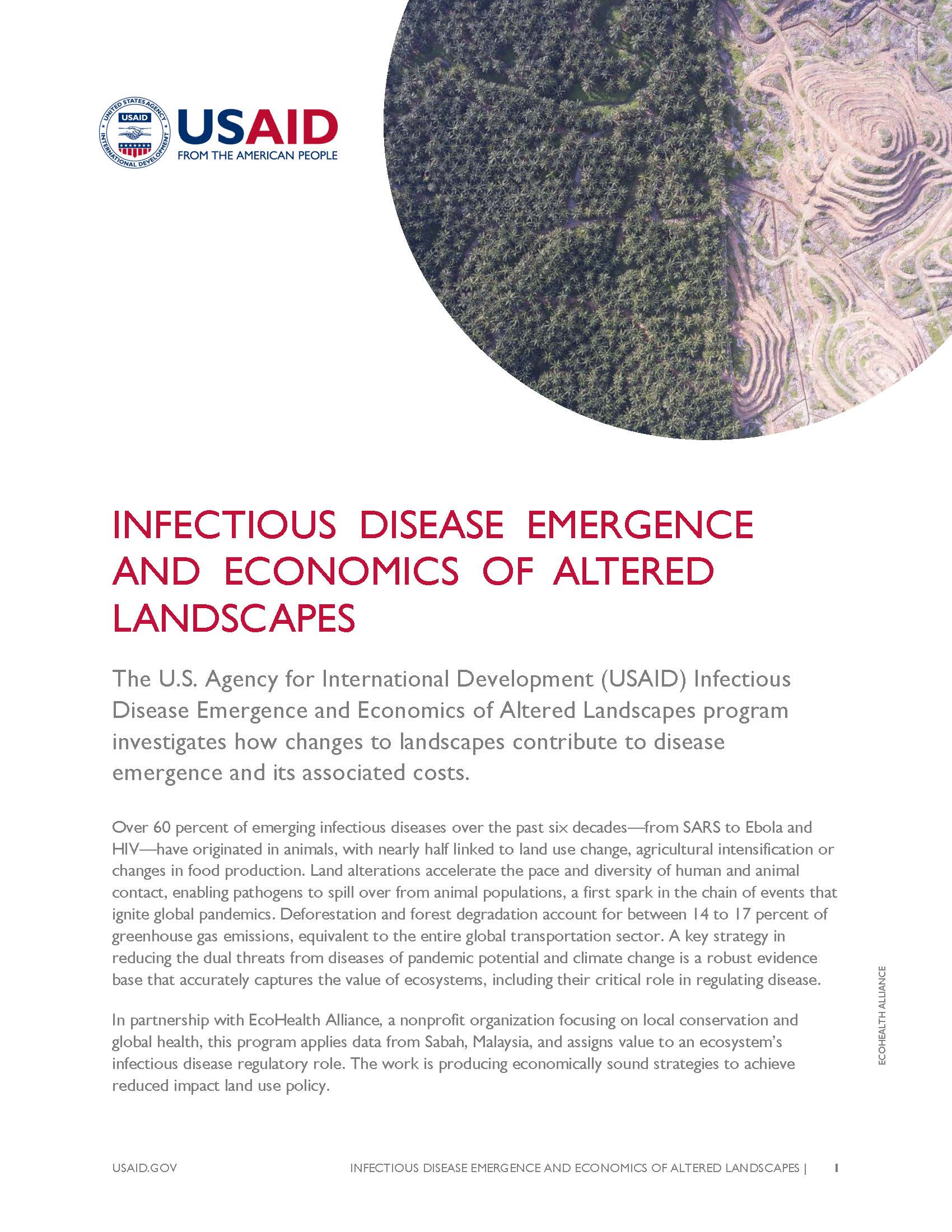The U.S. Agency for International Development (USAID) Infectious Disease Emergence and Economics of Altered Landscapes program investigates how changes to landscapes contribute to disease emergence and its associated costs.
Over 60 percent of emerging infectious diseases over the past six decades—from SARS to Ebola and HIV—have originated in animals, with nearly half linked to land use change, agricultural intensification or changes in food production. Land alterations accelerate the pace and diversity of human and animal contact, enabling pathogens to spill over from animal populations, a first spark in the chain of events that ignite global pandemics. Deforestation and forest degradation account for between 14 to 17 percent of greenhouse gas emissions, equivalent to the entire global transportation sector. A key strategy in reducing the dual threats from diseases of pandemic potential and climate change is a robust evidence base that accurately captures the value of ecosystems, including their critical role in regulating disease.
In partnership with EcoHealth Alliance, a nonprofit organization focusing on local conservation and global health, this program applies data from Sabah, Malaysia, and assigns value to an ecosystem’s infectious disease regulatory role. The work is producing economically sound strategies to achieve reduced impact land use policy.
COSTING DISEASE EMERGENCE
The program builds upon USAID’s investments in pathogen discovery and characterization of disease emergence risk. Leveraging existing data and ongoing pathogen surveillance, the program’s economic model projects expected costs attributable to disease burden as a function of land alterations. These costs—from care and treatment, emergency response and containment to travel and trade restrictions, border closures and market shocks— provide valuable information for discussion among governments, the private sector and civil society to define optimal land use policies. Adapted to other locations and contexts, this new methodology holds promise to achieve reduced impact land-use planning.
INFLUENCING LAND USE POLICY
Universiti Malaysia Sabah and its Development and Health Research Unit (DHRU) serve as a training and resource sharing platform, organizing roundtables on the economic relationship between land use change and disease emergence. The DHRU brings together a diverse group of faculty and students who form a regional resource for expertise in applying models to inform land-use planning. Emerging infectious disease of pandemic potential and unchecked climate change threaten social and economic stability and represent significant impediments to sustainable development. Capturing the economic impact of disease emergence presents an opportunity to promote sustainable land use policies to mitigate these threats, leveraging USAID’s partnerships and expertise developing solutions to pressing development challenges.
IMPACT AND RESULTS
- Developed and field trialed a new economic modeling approach capable of valuing an ecosystem’s disease regulatory role, which is currently informing land use policy decisions in Sabah, Malaysia.
- Established the Development and Health Research Unit at Universiti Malaysia Sabah, enrolling three Malaysian graduate students in studies on land use and disease emergence.
- Developed a health and land use change tool kit presented to 554 people from industry and government and more than 50 communities across Sabah.
- Contributed to the scientific literature on innovative strategies to realize reduced impact land use through nine peer-reviewed abstracts and presentations at international symposia.
PARTNERS
EcoHealth Alliance, Sabah Wildlife Department, Universiti Malaysia Sabah, Sabah State Health Department, Peninsular Malaysia and Sabah authorities.
Click here for the pdf version.








Comment
Make a general inquiry or suggest an improvement.